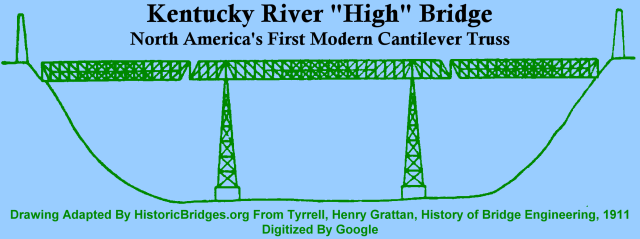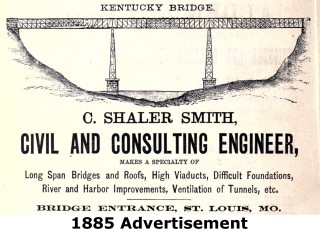We Recommend:
Bach Steel - Experts at historic truss bridge restoration.
BridgeHunter.com Phase 1 is released to the public! - Visit Now
High Bridge

Primary Photographer(s): Dave Michaels
Bridge Documented: November 28, 2009
Railroad (Norfolk Southern, Cincinnati Southern) Over Kentucky River
Rural: Jessamine County, Kentucky and Mercer County, Kentucky: United States
Metal Continuous (Straight Chords) 12 Panel Rivet-Connected Baltimore Deck Truss, Fixed and Approach Spans: Metal Deck Girder, Fixed
1911 By Builder/Contractor: American Bridge Company of New York, New York and Engineer/Design: Gustav Lindenthal
Not Available or Not Applicable
353.0 Feet (107.6 Meters)
1,173.0 Feet (357.5 Meters)
Not Available
3 Main Span(s) and 2 Approach Span(s)
Not Applicable

View Information About HSR Ratings
Bridge Documentation
View Historic American Engineering Record (HAER) Documentation For This Bridge
View Historical Articles About This Bridge
View Historical Articles About The Previous Bridge At This Location

About This Bridge
This bridge is an extremely massive and tall deck truss. The bridge was designed by famous bridge engineer Gustav Lindenthal and completed in 1911. The bridge has been incorrectly reported in numerous sources as a cantilever truss built in 1877. The bridge built in 1911 is what is seen today and it is a complete replacement (both superstructure and steel bents) for the bridge built in 1877. The bridge was carefully designed and constructed around the 1877 bridge so that the replacement bridge could occupy the same footprint, but not interrupt rail traffic during construction. The level of the railroad tracks was also raised slightly in the 1911 bridge. This bridge is significant for its association with noted engineer Gustav Lindenthal and for its unusual method of construction. A diagram of the bridge as well as two photos showing the bridge's construction are shown below.
The First (Failed) Attempt At A Bridge
The first attempt to build a bridge at this crossing was made in 1854, when famous suspension bridge engineer John Roebling began the construction of a suspension bridge here. He completed the stone towers, but in 1857 the project was abandoned due to the Panic of 1857. When a different bridge, a cantilever truss bridge, was completed here in 1877, the stone towers remained. Even when the current bridge replaced the 1877 bridge, these towers still remained standing. It was only in 1929 when these towers were demolished so that the railroad line could be redesigned to accommodate a double track configuration.
The First Completed Bridge
The first noteworthy modern cantilever bridge in North America, was C. Shaler Smith's Kentucky River Bridge for the Cincinnati Southern Railway built in 1877. This was the world's longest cantilever at the time and was also claimed to be the tallest bridge constructed at the time. It was an unusual structure, and did not have a traditional cantilever design. In both appearance and design, it was essentially a continuous deck truss bridge with hinges, which made the bridge function as a cantilever truss with no suspended span. The design appears to have been chosen mainly to allow for better expansion/contraction of the bridge under load and temperature. This bridge was replaced by the current 1911 bridge.
![]()
Photo Galleries and Videos: High Bridge
Bridge Photo-Documentation
Original / Full Size PhotosA collection of overview and detail photos. This gallery offers photos in the highest available resolution and file size in a touch-friendly popup viewer.
Alternatively, Browse Without Using Viewer
![]()
Bridge Photo-Documentation
Mobile Optimized PhotosA collection of overview and detail photos. This gallery features data-friendly, fast-loading photos in a touch-friendly popup viewer.
Alternatively, Browse Without Using Viewer
![]()
Maps and Links: High Bridge
Coordinates (Latitude, Longitude):
Search For Additional Bridge Listings:
Bridgehunter.com: View listed bridges within 0.5 miles (0.8 kilometers) of this bridge.
Bridgehunter.com: View listed bridges within 10 miles (16 kilometers) of this bridge.
Additional Maps:
Google Streetview (If Available)
GeoHack (Additional Links and Coordinates)
Apple Maps (Via DuckDuckGo Search)
Apple Maps (Apple devices only)
Android: Open Location In Your Map or GPS App
Flickr Gallery (Find Nearby Photos)
Wikimedia Commons (Find Nearby Photos)
Directions Via Sygic For Android
Directions Via Sygic For iOS and Android Dolphin Browser
USGS National Map (United States Only)
Historical USGS Topo Maps (United States Only)
Historic Aerials (United States Only)
CalTopo Maps (United States Only)











